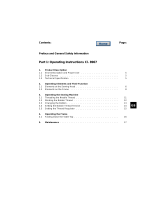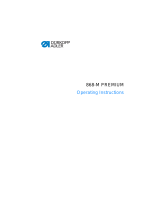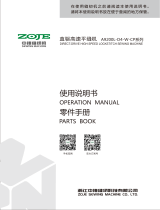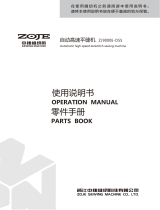Page is loading ...

806N-111
806N-121
Operating Instructions

All rights reserved.
Property of Dürkopp Adler AG and protected by copyright. Any reuse of these contents,
in
cluding extracts, is prohibited without the prior writte
n approval of Dürkopp Adler AG.
Copyright © Dürkopp Adler AG 2016
IMPORTANT
READ CAREFULLY BEFORE USE
KEEP FOR FUTURE REFERENCE

Table of Contents
Operating Instructions 806N-111/806N-121 - 03.0 - 07/2016 1
1 About these instructions ...........................................................5
1.1 For whom are these instructions intended?..................................5
1.2 Representation conventions – symbols and characters...............5
1.3 Other documents..........................................................................6
1.4 Liability..........................................................................................7
2 Safety...........................................................................................9
2.1 Basic safety instructions...............................................................9
2.2 Signal words and symbols used in warnings..............................11
3 Machine description.................................................................15
3.1 Components of the machine.......................................................15
3.1.1 Control panel..............................................................................15
3.1.2 Edge folding station....................................................................16
3.1.3 Sewing unit.................................................................................18
3.1.4 Stacker .......................................................................................19
3.1.5 Main switch.................................................................................19
3.2 Proper use..................................................................................20
3.3 Declaration of Conformity...........................................................21
4 Operation...................................................................................23
4.1 Preparing the machine for operation..........................................23
4.2 Switching on the machine...........................................................23
4.3 Changing the needle ..................................................................24
4.4 Threading the needle thread (806N-121)...................................26
4.5 Threading the needle thread (806N-111)...................................28
4.6 Winding the hook thread (806N-121) .........................................30
4.7 Winding the hook thread (806N-111) .........................................31
4.8 Changing the hook thread bobbin (806N-121)...........................32
4.9 Changing the hook thread bobbin (806N-111)...........................34
4.10 Thread tension............................................................................35
4.10.1 Setting the needle thread tension (806N-121)............................36
4.10.2 Setting the needle thread tension (806N-111)............................37
4.10.3 Setting the hook thread tension..................................................38
4.11 Setting the sewing foot...............................................................39
4.11.1 Setting the sewing foot height ....................................................39
4.11.2 Setting the upper stroke position................................................40
4.12 Changing the shaping assembly ................................................40
4.12.1 Removing the shaping assembly................................................43
4.12.2 Inserting the shaping assembly..................................................46
4.13 Performing a test run..................................................................50
4.14 Sewing after a needle thread breakage......................................51
4.15 How to act in case of an emergency (EMERGENCY STOP).....52
4.15.1 Activating safety equipment........................................................52
4.15.2 Deactivating safety equipment ...................................................53
4.16 Sewing (806N-111 and 806N-121).............................................55
4.17 Sewing (806N-521).....................................................................58
4.18 Switching off the machine...........................................................61
5 Programming ............................................................................65
5.1 Structure of the software ............................................................65
5.2 Functions of the software ...........................................................66

Table of Contents
2 Operating Instructions 806N-111/806N-121 - 03.0 - 07/2016
5.2.1 Start screen ................................................................................66
5.2.2 Pocket mode selection window ..................................................67
5.2.3 Seam program selection window................................................67
5.2.4 User interface 1 ..........................................................................68
5.2.5 User interface 2 ..........................................................................70
5.2.6 Exiting selection window.............................................................72
5.3 Operating software version.........................................................73
5.4 Making the basic settings...........................................................74
5.5 User interface 1 ..........................................................................74
5.5.1 Selecting a pocket mode............................................................75
5.5.2 Resetting the piece counter........................................................80
5.5.3 Setting the bobbin counter..........................................................80
5.5.4 Enabling bundle removal............................................................82
5.5.5 Activating middle slide automatically forward.............................83
5.5.6 Activating the alignment of strips................................................84
5.5.7 Initiating a change of shape........................................................85
5.6 User interface 2 ..........................................................................85
5.6.1 Working step-by-step..................................................................86
5.6.2 Activating Sewing without edge folding......................................87
5.6.3 Switching the stroke position on/off............................................87
5.6.4 Activating needle cooling............................................................88
5.6.5 Activating the needle thread monitor..........................................88
5.6.6 Activating automatic air suction..................................................89
5.6.7 Selecting and deselecting stacker variants ................................90
5.6.8 Setting the outfeed roller path ....................................................91
5.6.9 Activating the advance roller ......................................................93
5.6.10 Setting the sewing motor speed.................................................93
5.6.11 Attach flap (only 806N-521)........................................................94
6 Maintenance..............................................................................95
6.1 Cleaning .....................................................................................95
6.2 Lubricating (806N-121)...............................................................97
6.3 Lubricating (806N-111)...............................................................99
6.4 Maintaining the pneumatic system...........................................101
6.4.1 Setting the operating pressure .................................................101
6.4.2 Draining the water condensation..............................................102
6.4.3 Cleaning the filter element........................................................104
6.5 Parts list....................................................................................105
7 Setup........................................................................................107
7.1 Checking the scope of delivery.................................................107
7.2 Removing and assembling the covers......................................108
7.2.1 Removing the covers................................................................108
7.2.2 Assembling the covers .............................................................112
7.3 Removing the transport locks...................................................115
7.4 Setting up the sewing unit ........................................................117
7.4.1 Aligning the machine ................................................................117
7.4.2 Assembling the thread reel holder............................................118
7.5 Electrical connection.................................................................119
7.6 Pneumatic connection..............................................................120
7.6.1 Connecting the compressed air maintenance unit....................120
7.6.2 Setting the operating pressure .................................................121

Table of Contents
Operating Instructions 806N-111/806N-121 - 03.0 - 07/2016 3
7.6.3 Lubricating wicks and felt .........................................................121
8 Decommissioning...................................................................123
9 Packaging and transport .......................................................125
9.1 Assembling the transport locks.................................................125
9.1.1 Assembling the sewing head transport locks............................125
9.1.2 Assembling the transport lock on the edge folding station.......126
9.1.3 Assembling the stacker transport locks....................................126
9.1.4 Assembling the transfer carriage transport locks......................126
9.1.5 Securing power cable and pedal for transport..........................126
9.2 Packing the machine................................................................127
9.3 Transporting the machine.........................................................127
10 Disposal...................................................................................129
11 Troubleshooting .....................................................................131
11.1 Customer Service.....................................................................131
11.2 Messages of the software.........................................................131
11.2.1 Information messages..............................................................131
11.2.2 Error messages........................................................................132
11.3 Errors in sewing process ..........................................................133
12 Technical data.........................................................................135
13 Glossary ..................................................................................137
14 Appendix .................................................................................139

Table of Contents
4 Operating Instructions 806N-111/806N-121 - 03.0 - 07/2016

About these instructions
Operating Instructions 806N-111/806N-121 - 03.0 - 07/2016 5
1 About these instructions
These instructions have been prepared with utmost care. They contain in-
formation and notes intended to ensure long-term and reliable operation.
Should you notice any discrepancies or if you
have improvement requests,
then we would be glad to receive your feedback through Customer Service
( p. 131).
Consider the instructions part of the product and store them in a place
whe
re they are readily available.
1.1 For whom are these instructions intended?
These instructions are intended for:
• Operators:
This group is familiar with the machine an
d has access to the
instructions. Specifically, chapter Operation ( p. 23) is important
for the operators.
• Specialists:
This group has the appropriate technical training for performing
ma
intenance or repairing malfunctions. Specifically, the chapter
Setup ( p. 107) is important for specialists.
Service Instructions are supplied separately.
With regard to minimum qualification and other requirements to be met by
p
ersonnel, please also follow the chapter Safety ( p. 9).
1.2 Representation conventions – symbols and characters
Various information in these instructions is represented or highlighted by the
following characters in order to facilitate easy and quick understanding:
Proper setting
Specifies proper setting.
Disturbances
Specifies the disturbances that can occur due to an incorrect setting.
Cover
Specifies which covers must be removed in order to access the compo-
nents to be set.

About these instructions
6 Operating Instructions 806N-111/806N-121 - 03.0 - 07/2016
Steps to be performed when operating the machine (sewing and
equipping)
Steps to be performed for service, maintenance, and installation
Steps to be performed via the software control panel
The individual steps are numbered:
1. First step
2. Second step
The steps must always be followed in the specified order.
Lists are marked by bullet points.
Result of performing an operation
Change to the machine or on the display/control panel.
Important
Special attention must be paid to this point when performing a step.
Information
Additional information, e.g. on alternative operating options.
Order
Specifies the work to be performed before or after a setting.
References
Reference to another section in these instructions.
Safety Important warnings for the machine users are specially designated.
Since safety is of particular importance, hazard symbols, levels of danger
a
nd their signal words are described separately in the chapter Safety
( p. 9).
Location
information
If no other clear location information is used in a figure, indications of right
or left are always from the user's point of view.
1.3 Other documents
The machine includes components from other manufacturers. Each man-
ufacturer has performed a hazard assessment for the
se purchased parts
and confirmed their design compliance with applicable European and na-
tional regulations. The proper use of the built-in compone
nts is described
in the corresponding manufacturer's instructions.
1.
2.
…
•

About these instructions
Operating Instructions 806N-111/806N-121 - 03.0 - 07/2016 7
1.4 Liability
All information and notes in these instructions have been compiled in ac-
cordance with the latest technology and the applicable standards and reg-
ulations.
Dürkopp Adler cannot be held liable for any damage resulting from:
• Breakage and damage during transport
• Failure to observe these instructions
• Improper use
• Unauthorized modifications to the machine
• Use of untrained personnel
• Use of unapproved parts
Transport
Dürkopp Adler cannot be held liable for brea
kage and transport damages.
Inspect the delivery immediately upon receiving it. Report any damage
to the last transport manager. This applies even if the packaging is
u
ndamaged.
Leave machines, equipment and packaging material in the condition in
which they
were found when the damage was discovered. This will ensure
any claims against the transport company.
Report all other complaints to Dürkopp Adler immediately after receiving
t
he product.

About these instructions
8 Operating Instructions 806N-111/806N-121 - 03.0 - 07/2016

Safety
Operating Instructions 806N-111/806N-121 - 03.0 - 07/2016 9
2 Safety
This chapter contains basic information for your safety. Read the instruc-
tions carefully before setting up or operating the machine. Make sure to
f
ollow the information included in the safety instructions. Failure to do so
can result in serious injury and property damage.
2.1 Basic safety instructions
The machine may only be used as described in these instructions.
These instructions must be available at the machine's location at all times.
Work on live components and equipment is prohibited
. Exceptions are de-
fined in the DIN VDE 0105.
For the following work, shut down the computer FIRST BEFORE switching
o
ff the machine at the main switch or disconnecting the power plug:
• Replacing the needle or other sewing tools
• Leaving the workstation
• Performing maintenance work and repairs
• Threading
Missing or faulty parts could impair safety and damage the machine.
Only use original parts from the manufacturer.
Transport Use a lifting carriage or forklift to transport the machine. Raise the ma-
chine max. 20 mm and secure it against slipping.
Setup The connecting cable must have a power plug approved in the relevant
country. The power plug may only be assembled to the power cable by
qualified specialists.
Obligations
of the operator
Follow the country-specific safety and accident prevention regulations and
the legal regulations concerning industrial safety and the protection of the
environment.
All the warnings and safety signs on the machine must always be in legible
cond
ition. Do not remove!
Missing or damaged warnings and safety signs must be replaced
immedia
tely.
Requirements
to be met by the
per
sonnel
Only qualified specialists may:
• set up the machine
• perform maintenance work and repairs
• perform work on electrical equipment
Only authorized persons may work on the machine and must first have un-
derstood these instructions.

Safety
10 Operating Instructions 806N-111/806N-121 - 03.0 - 07/2016
Operation Inspect the machine while in use for any externally visible damage.
Stop working if you notice any changes to the machine. Report any chang-
es to your supervisor. Do not use a damaged machine any further.
Safety
equipment
Safety equipment should not be removed or deactivated. If it is essential
to remove or deactivate safety equipment for a repair operation, it must be
assembled and put back into operation immediately afterward.
The safety equipment is located at the illu
strated positions on the
machine:
Fig. 1: Safety equipment
The following safety equipment are mounted on the machine:
(1) - Protective hood
(2) - EMERGENCY STOP button
(3) - Integrated EMERGENCY STOP
(4) - Metal bar
Figure Designation Purpose
EMERGENCY
ST
OP button
The machine is immediately placed
in the EMERGENCY STOP state:
– The motors are braked and then
d
isconnected from the power.
– The cylinders are depressurized.
①②③ ④

Safety
Operating Instructions 806N-111/806N-121 - 03.0 - 07/2016 11
2.2 Signal words and symbols used in warnings
Warnings in the text are distinguished by color bars. The color scheme
based on the severity of the danger. Signal words indicate the severity of
the danger.
Signal words Signal words and the hazard they describe:
EMERGENCY
STOP
integrated
The machine is immediately placed
in the EMERGENCY STOP state:
– The motors are disconnected
from th
e power.
– The cylinders are depressurized.
Metal bar Defines limits for the user to pro-
vide protection from injury.
Protective hood Protects the user from i
njury and
protects the electrical and mechan-
ical elements of the machine from
soiling.
Figure Designation Purpose
Signal word Meaning
DANGER (with hazard symbol)
If ignored, fatal or serious injury will result
WARNING (with hazard symbol)
If ignored, fatal or serious injury can result
CAUTION (with hazard symbol)
If ignored, moderate or m
inor injury can result
CAUTION (with hazard symbol)
If ignored, environmental damage can result
NOTICE (without hazard symbol)
If ignored, property damage can result

Safety
12 Operating Instructions 806N-111/806N-121 - 03.0 - 07/2016
Symbols The following symbols indicate the type of danger to personnel:
Examples Examples of the layout of warnings in the text:
This is what a warnin
g looks like for a hazard that will result in serious
injury or even death if ignored.
This is wh
at a warning looks like for a hazard that could result in seri-
ous or even fatal injury if ignored.
Symbol Type of danger
General
Electric shock
Puncture
Crushing
Environmental damage
DANGER
Type and source of danger!
Consequences of non-compliance.
Measures for avoiding the danger.
WARNING
Type and source of danger!
Consequences of non-compliance.
Measures for avoiding the danger.

Safety
Operating Instructions 806N-111/806N-121 - 03.0 - 07/2016 13
This is what a warning looks like for a hazard that could result in
moderate or minor injury if the warning is ignored.
This is what a warning looks like for a hazard that could result in envi-
ronmental damage if ignored.
This is what a warn
ing looks like for a hazard that could result in
property damage if ignored.
CAUTION
Type and source of danger!
Consequences of non-compliance.
Measures for avoiding the danger.
CAUTION
Type and source of danger!
Consequences of non-compliance.
Measures for avoiding the danger.
NOTICE
Type and source of danger!
Consequences of non-compliance.
Measures for avoiding the danger.

Safety
14 Operating Instructions 806N-111/806N-121 - 03.0 - 07/2016

Machine description
Operating Instructions 806N-111/806N-121 - 03.0 - 07/2016 15
3 Machine description
3.1 Components of the machine
Fig. 2: Components of the machine
3.1.1 Control panel
Fig. 3: Control panel
You can use the touchscreen (1) to set up the sewing unit.
(1) - Control panel
(2) - Edge folding station
(3) - Pedal (not shown)
(4) - Main switch
(5) - Stacker
(6) - Sewing unit
(1) - Touchscreen (2) - USB port
①
②
③
④
⑤
⑥
①
②

Machine description
16 Operating Instructions 806N-111/806N-121 - 03.0 - 07/2016
You can import new pocket seam programs, seam programs or other soft-
ware via the USB port (2) or network interface in the housing.
3.1.2 Edge folding station
Fig. 4: Edge folding station
Place the fabric parts to be sewn on the edge folding station:
• The basic part on the sewing material support surface (7) with integrated
hose inse
rt (optional) (4)
• The pocket blank on the middle slide (3)
The edge folding frame (2) is used to fold the (edge) of the pocket blanks.
Furthermore, two buttons (5, 6) and the pedal (8) used to start the sewing
cycle can b
e found here.
The keypad (1) is used to operate the mechanical components and displays
the operating status.
Keypad
The individual elements of the key panel always have two components:
• Button
• Label field
(1) - Keypad
(2) - Edge folding frame
(3) - Middle slide
(4) - Hose insert (optional)
(5) - Button 1
(6) - Button 2
(7) - Sewing material support surface
(8) - Pedal (not shown)
①
②
③
④
⑦
⑥
⑤

Machine description
Operating Instructions 806N-111/806N-121 - 03.0 - 07/2016 17
A description of the function can be found in the table below in addition to
the figure and designation of the buttons
Button Designation Function
Stop button
The s
top button does not light up.
If you press the s
top button, the machine
ends the current work step and comes to
a safe stop. The activities described in
Chapter 5.8 Activities on the machine
ca
n be performed safely.
Start button
The st
art button can light up or flash in
green. If the start button lights up, you
can start a procedure on the machine by
pressing button 1. If the start button
flashes, an error has to be eliminated or a
requirement met. Next, press button 1 to
resume the procedure.
Cancel button
The cancel button does no
t light up.
The current edge folding procedure is
stopped by pressing the cancel button.
The sewing procedure is resumed.
Safe stop
Safe stop
is not a button, but a lamp
which lights up in white. The sa
fe stop
lamp indicates that no working procedure
is active. The activities described in
Chapter 5.8 Activities on the machine
ca
n be performed safely.
EMERGENCY
STOP
The EMERGENCY ST
OP button does not
light up. The machine stops all procedures
and is disconnected from the power supply
if you press the EMERGENCY STOP
button. The EMERGENCY STOP button
must be reactivated after actuation in order
to resume work, Chapter 5.10,
Emergency procedure.

Machine description
18 Operating Instructions 806N-111/806N-121 - 03.0 - 07/2016
Buttons
The buttons and the pedal are used to operate the machine. A descrip-
tion of the function can be found in the table below in addition to the figure
a
nd designation of the buttons.
3.1.3 Sewing unit
Fig. 5: Sewing unit
The transfer frame (1) of the sewing unit moves to the edge folding station.
The fabric parts are transported from the edge folding station to the sewing
unit by means of the transfer plate (3).
The sewing head (2) lowers, and the fabric parts are sewn together.
Button Designation Function
Button 1 Button 1 (on the left side):
• starts a sewing cycle
• activates the air suction for the basic
p
art and pushes the middle slide into
the front position
• navigates stitch by stitch
to the correct
point after a needle thread breakage
Button 2 Button 2 (on the right side):
• lowers the middle slide into the front
position
• raises the middle slide into the front
position
Pedal Pedal:
• activates the air suction for the basic
part
• moves the middle slide into the front
position
(1) - Transfer frame
(2) - Sewing head
(3) - Transfer plate
①
②
③
/












